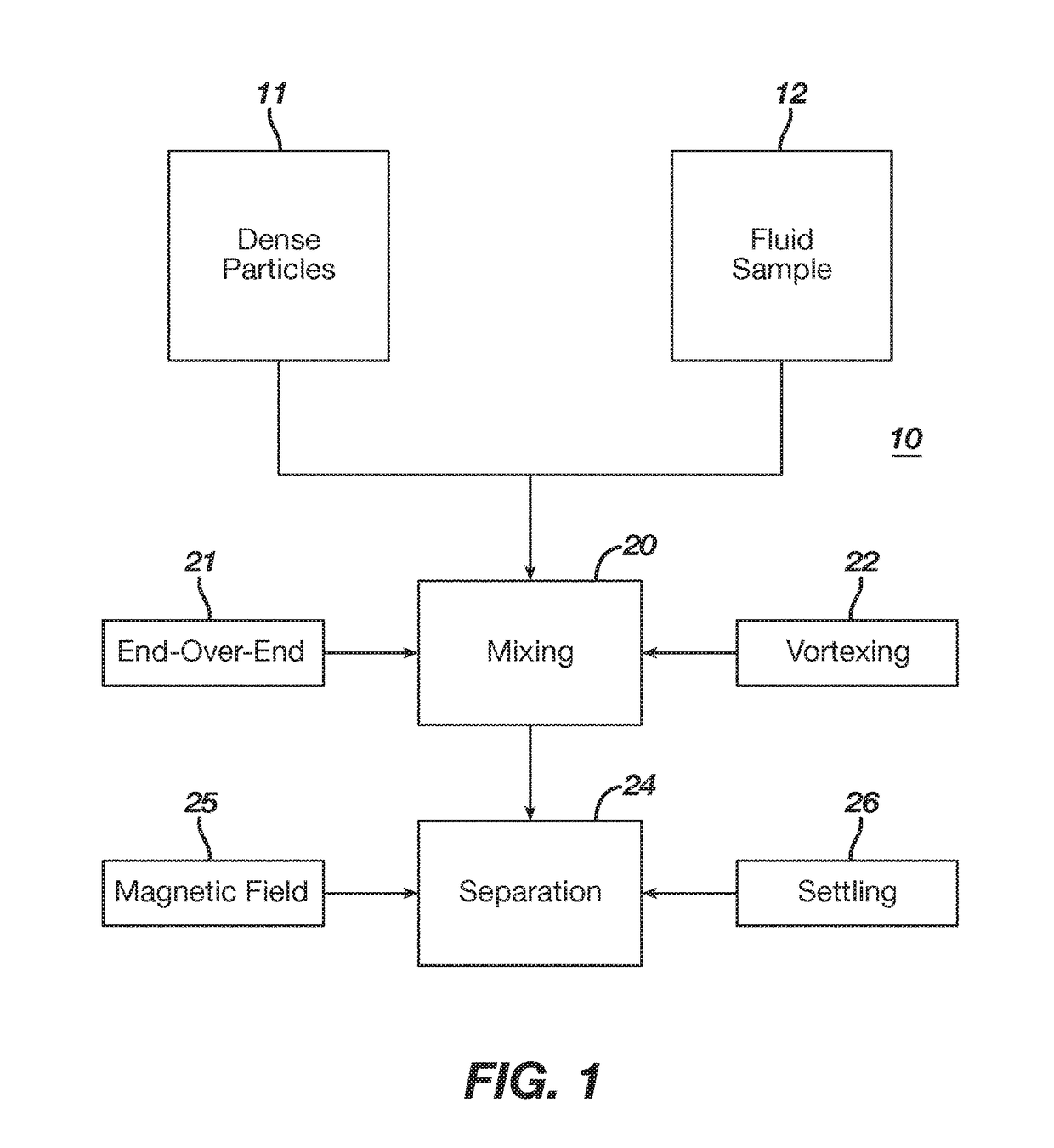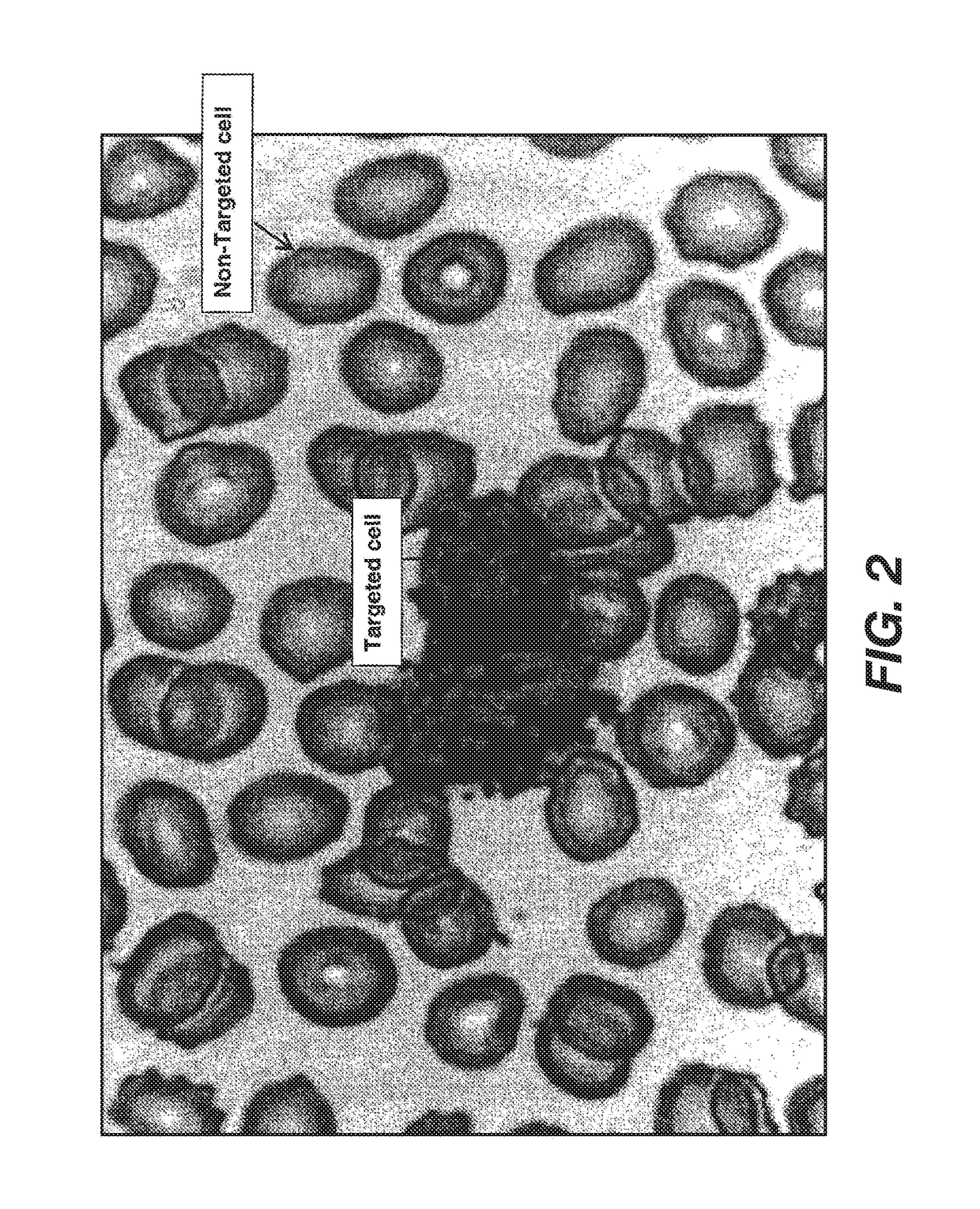Methods and reagents for improved selection of biological materials
a biological material and reagent technology, applied in the field of new ferromagnetic dense particles, can solve the problems of superparamagnetic materials that are highly magnetically susceptible, ferromagnetic particles with permanent magnetization, and rapidly lose their magnetism, and achieves low centrifugation time and speed, rapid and efficient mixing, and easy attachment.
- Summary
- Abstract
- Description
- Claims
- Application Information
AI Technical Summary
Benefits of technology
Problems solved by technology
Method used
Image
Examples
example 1
Granulocytes are Efficiently Separated from Whole Blood Using Antibody Labeled Ferromagnetic Dense Particles of the Invention
[0061]CD15 is present on the majority (>99%) of granulocytes, a major subpopulation of leukocytes. Anti-CD15-nickel particles were used to test the specific selection of targeted cells and the effect of the particles on removal of non-targeted cells non-specifically. Nickel particles were labeled with an anti-CD15 monoclonal antibody (Beckman Coulter, Miami, Fla.) by adsorption. 100 ul of a 20% wt / volume of CD15-nickel particles were added to one ml whole blood in a 12×75 mm glass test tube. The sample was mixed end-over-end at 30 rpm for five minutes and then immediately separated by placement in a magnet for another five minutes. The supernatant was removed and analyzed on a hematology analyzer (Sysmex KX-21, Roche Diagnostics Corp.) for depletion of granulocytes. FIG. 3A demonstrates the three major subpopulations (lymphocytes, monocytes and granulocytes) t...
example 2
Leukocyte Populations and Subpopulations are Selected Using Multiple Binding Agents Specific to Different Molecules
[0062]Ferromagnetic dense particles of the present invention can be used with one antibody bound to the particle or multiple antibodies bound to a single particle in order to effectively select all populations of interest. In this example CD15-ferromagnetic dense particles (one ml whole blood; mixing end-over-end at 30 rpm for five min; separating for five min in a magnetic field) effectively selected for granulocytes, as shown in Example 1. Again the selection of granulocytes was greater than 99% without any loss in lymphocytes (Table 1; FIG. 4B) compared to control (FIG. 4A), demonstrating the specific selection of target cells without non-specific loss of non-targeted cells. CD15 is expressed on monocytes, but the antigen density per cell is at least a log lower than the antigen density on granulocytes. Thus, CD15 only selected for 17% of the monocytes. In order to i...
example 3
Particles of the Invention have a Dramatically Reduced Mixing Time and Magnetic Separation Time Compared with Colloidal Superparamagnetic Particles
[0064]Colloidal superparamagnetic particles effectively select desired populations but mixing times and magnetic separation times are known in the art to be relatively long because of the superparamagnetic nature of the particles. CD45-superparamagnetic particles were used to select leukocytes from whole blood. According to manufacturer's instructions, mixing time was 15 minutes and magnetic separating time was 15 minutes. Time parameters chosen in Table 2 are above and below the manufacture's values.
TABLE 2PERCENT LEUKOCYTESELECTION METHODSELECTIONCD45-superparamagnectic particles92(30 min)CD45-superparamagnectic particles8(10 min)CD45-nickel particles (30 min)92CD45-nickel particles (10 min)95
[0065]These results (Table 2) show that CD45-superparamagnetic particles effectively select leukocytes but, when the mixing / separation times are d...
PUM
| Property | Measurement | Unit |
|---|---|---|
| diameter | aaaaa | aaaaa |
| diameter | aaaaa | aaaaa |
| diameter | aaaaa | aaaaa |
Abstract
Description
Claims
Application Information
 Login to View More
Login to View More - R&D
- Intellectual Property
- Life Sciences
- Materials
- Tech Scout
- Unparalleled Data Quality
- Higher Quality Content
- 60% Fewer Hallucinations
Browse by: Latest US Patents, China's latest patents, Technical Efficacy Thesaurus, Application Domain, Technology Topic, Popular Technical Reports.
© 2025 PatSnap. All rights reserved.Legal|Privacy policy|Modern Slavery Act Transparency Statement|Sitemap|About US| Contact US: help@patsnap.com



